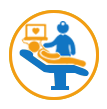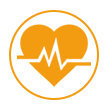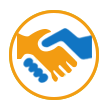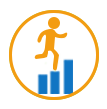PATIENT DETAILS
PATIENT DETAILS
Stroke
Rehabilitation
Rehabilitative care in collaboration with scientific technology, at your service.
Stroke is one of the leading causes of death and disabilities worldwide with over 15 million people (as per reports furnished by WHO) across the world falling prey to this disease every year. It is caused when a blood vessel carrying blood and nutrition to the brain is either clogged or bursts, giving rise to a hypoxic (lack of oxygen) condition amongst the brain cells (neurons). This leads to the premature death of neurons which induces a wide range of physical and psychological impairments in patients like lack of sensation on one side of the body, difficulty speaking, disorientation, restrained motor skills, etc.
Stroke is one of the most worrying consequences of sedentary modern-day lifestyle as people with high cholesterol, diabetes, obesity, and hypertension are considered to be at higher risk.
Stroke can be classified into 4 main kinds:
- Ischemic Stroke: It accounts for 87% of all strokes and results from obstruction of blood flow caused due to narrowing of the arteries leading to the brain.
- Haemorrhagic Stroke: It occurs when a blood vessel ruptures giving rise to bleeding inside the brain. High blood pressure is the most common cause for haemorrhagic stroke.
- Transient Ischemic Stroke: As the name suggest, it’s a short-lived stroke caused due to a temporary clot in the blood vessels in the brain. Often, it’s a warning sign for an impending stroke and immediate medical consultation must be sought to avert a serious episode of stroke.
- Cryptogenic Stroke: When despite thorough evaluation the cause of stroke cannot be determined, it’s known as a cryptogenic stroke.
- Brain Stem Stroke: Stroke generally impacts the patient’s physical coordination on one side of the body, depending on the location of the stroke. In case of stroke in the brain stem, the patient loses complete coordination in either side of the body and is rendered ‘locked’ below the neck.
Stroke presents a wide range of symptoms involving physical difficulties and psychological disorientation. The most distinguishing symptoms are as follows:
- Sudden numbness in the face, arm or leg (especially on one side of the body)
- Difficulty speaking
- Blurred or double vision
- Fatigue
- Vertigo
- Loss of balance
- Reduced sensation to touch and pin pricks
The key to complete recovery in stroke is to act fast. The first four hours since the inception of stroke is regarded as the ‘golden hour’ by medical professionals and fetching treatment within the same leads to increased chances of complete recovery. To being with, the patient is administered with clot-buster injections to help dissolve the clot and restore normal blood flow to the brain.
In the acute care phase, patients are monitored closely at the hospital for their response to the treatment, the severity of the stroke and the extent of disability suffered. In severe cases, patients also exhibit respiratory challenges and are made to undergo tracheostomy – a surgical procedure to reinstate normal breathing by inserting a tube into the trachea (wind pipe) through an incision at the base of the neck. The intubation entails constant supervision of medical professionals to ensure aseptic conditions and prevent any external trauma to the site of the insertion that may lead to grave consequences.
Being a critical illness, recovering from stroke is a prolonged process and often, patients fail to regain complete mobility and cognitive functions by the end of their hospitalization. It’s to address this prevailing gap between recovery from illness and returning to life that stroke rehabilitation proves to be a crucial driving force.
Given the extent of impairments that stroke bring about in the lives of its survivors, the struggle to re-establish themselves into regular life continues every after they are released from the hospital. While most of their in-hospital treatment revolve around dissolving the cerebral clot in order to reinstate their physical abilities, the patients barely receive any rehabilitative support to help them overcome from the debilitating impacts of this life-threatening condition.
It’s in the confines of a rehabilitation hospital that their journey towards complete recovery begins under the able supervision of trained therapists, doctors and counsellors. Patients exhibiting disabilities concerning speech, mobility and coordination can greatly benefit stroke rehabilitation.
At ApoKOS Rehabilitation, our aim is to restore physical and mental health of the patients impacted by stroke by helping them regain their strength and independence and propelling them towards their regular life. The treatments offered to the patients during rehabilitation are as follows:
- Physical Therapy
- Occupational Therapy
- Speech and Swallow Therapy
- Robotics Technology
- Cognitive and Behaviour Therapy
- Bladder and Bowel Training
Physical Therapy
This is also known as rehab physiotherapy. It involves traditional rehabilitation methods along with cutting edge therapeutic approaches such as Manual Therapy, Geriatric Rehabilitation, Paediatric Rehabilitation, Cardio-pulmonary Rehabilitation, Robotics Technology, Neuromuscular Re-education Techniques, and Neuromuscular Pain Management with Electrotherapeutic Therapy. It comprises of a wide range of physical exercises that aims at regaining strength, balance and independence.
Occupational Therapy
This therapy aims at promoting health and wellbeing through regular conduction of occupational activities. The patient is given simple tasks to perform, to gradually regain their ability to function independently. Occupational therapy entails:
- Customised assessment of the current situation
- Intervention to ensure that the patients achieve the goals identified by the therapist
- Regular evaluation to keep track of the progress made by the patient
Speech and Swallow Therapy
This therapy is conducted by speech-language pathologists and is aimed at revival of the patient’s speech, understanding, voice coordination, and swallowing patterns. This therapy involves:
- Language therapy
- Non-vocal communication therapy
- Swallowing therapy and training
- Voice training
- Speech impairment
- Fluency development
- Cognitive training for understanding communicative patterns
Robotic Technology
To ensure proper rehabilitation, it is vital to conduct processes with the support of modern robotic technology that helps the patient regain balance and mobility. At ApoKOS, we deploy
- EKSO: This is a wearable suit that boosts strength, stamina, and mobility. EKSO is used to assist standing and gait training.
- ERIGO: This instrument is also used to assist standing, but for a more severely impaired and bed-ridden patient. ERIGO entails gradual ‘verticalization’ of the body with the support of passive robotic mobilisation.
- ARMEO POWER: ARMEO helps the patient gradually move their limbs and regain ability to function as independently as possible.
- BALANCE MASTER: This instrument helps the patient stand up and train to develop a balanced posture. With this, the patient can gradually re-learn to walk and move around.
Cognitive and Behaviour Therapy
Surviving stroke leads to side effects like loss of cognitive abilities, mood swings, anxiety, and inability to interact with other people. Cognitive and behaviour therapy is a psychosocial method used to rectify these disorders amongst patients.
The method involves:
- Psychosocial assessment of the patient by a physician
- Skill acquisition of the patient, identified by the therapist
- Application training that requires the patient to exercise their behavioural skills
- Stress reduction procedures
- Cognitive processing therapy
- Relaxation training
- Dialectical behaviour therapy
Bladder and Bowel Training
Life after stroke can be extremely testing with patients being entirely dependent on their caretakers for simple day-to-day activities. Not only does that severely wound their morale, but also make it extremely difficult for their family members to tend to them.
At ApoKOS Rehabilitation, we take special care in training the patients to perform independent, clean and intermittent CIC catheterization, thereby enabling them to lead a life of dignity and with freedom. We also specialize in providing tube feeding care and tracheostomy care.
At ApoKOS, we aim at fostering an environment of positivity and healing to help patients recuperating from critical illnesses return to life with revived spirit. We offer customised rehabilitation plan backed by advanced robotic technology and an equipped medical management team to take care of patient’s need at every step of their recovery.
Comprehensive Neuro treatment
Throughout the patient’s stay at our facility, our trained nurses take care of the medical needs of the patient. They also ensure that the treatment continues as per plan by coordinating with the various team members and through regular feedback from the patient and family.
Our neurological rehabilitation program offers seven salient features

Comprehensive
We aim at physical, psychological, cognitive, cultural and social aspects of the patients’ personalities, their stage of recovery and their own and their family’s lifestyle.

Patient-centric
We customize our healthcare strategies according to the patients and their families for the patient is at the centre of our entire rehabilitation process

Integrated
We design and follow a multidisciplinary approach which includes expert and motivated care personnels experienced in working in a team structure.

Inclusive
We believe in the power of family support for the patient’s optimum rehabilitation so we encourage the family’s active participation and cooperation in the recovery process.

Empowering
We want our patients to be as independent as possible so we try to empower them and build their confidence by reducing increased dependence on mobility aids.

Continuous
We provide all possible human and material resources to tackle each and every problem of the patient as and when they arise to help them achieve the highest level of recovery and independence.

Committed
We know that a patient needing neurological rehabilitation might develop several new complications with age, so we offer out-patient rehabilitation to keep track of their life-long progress.


